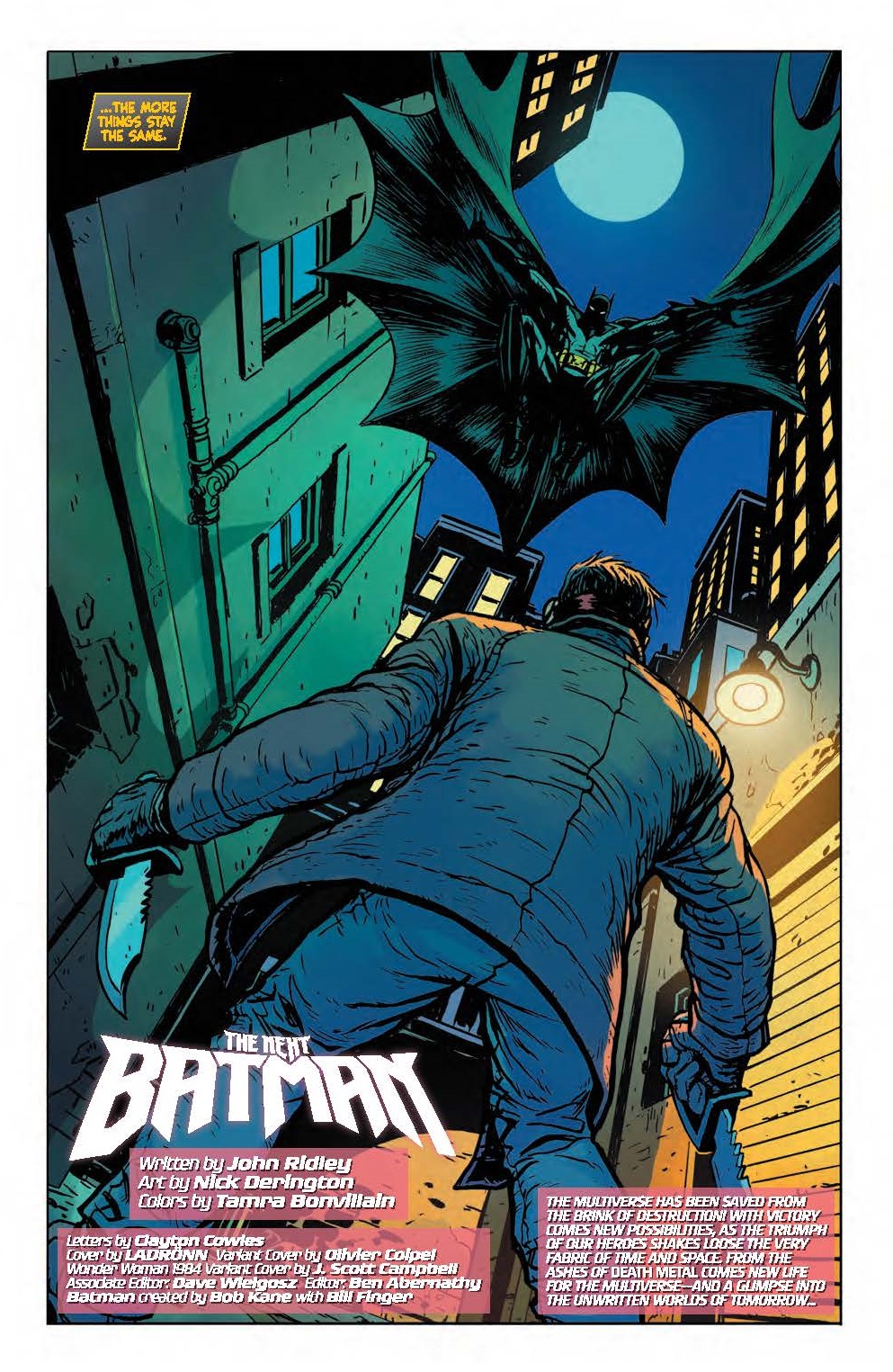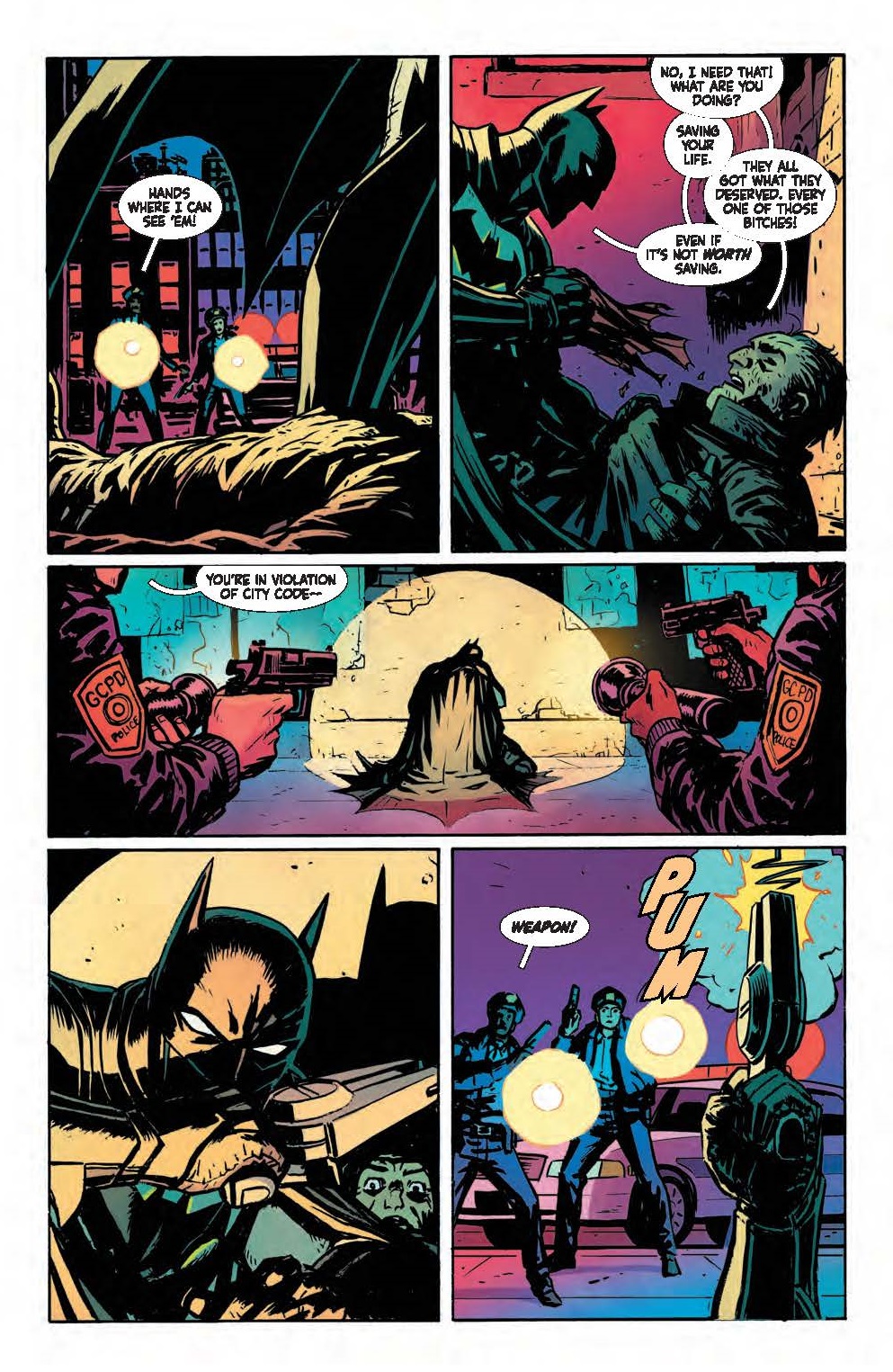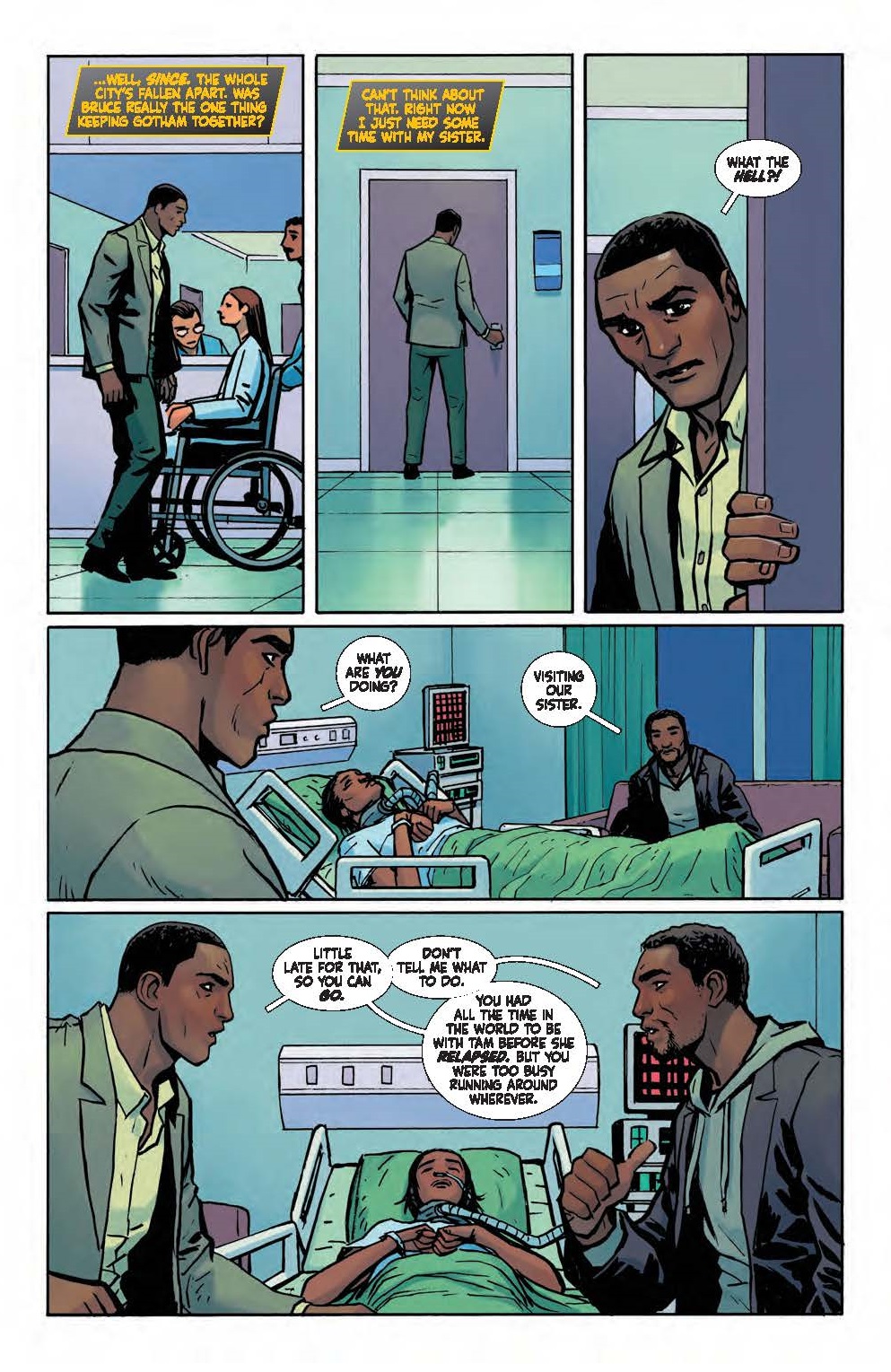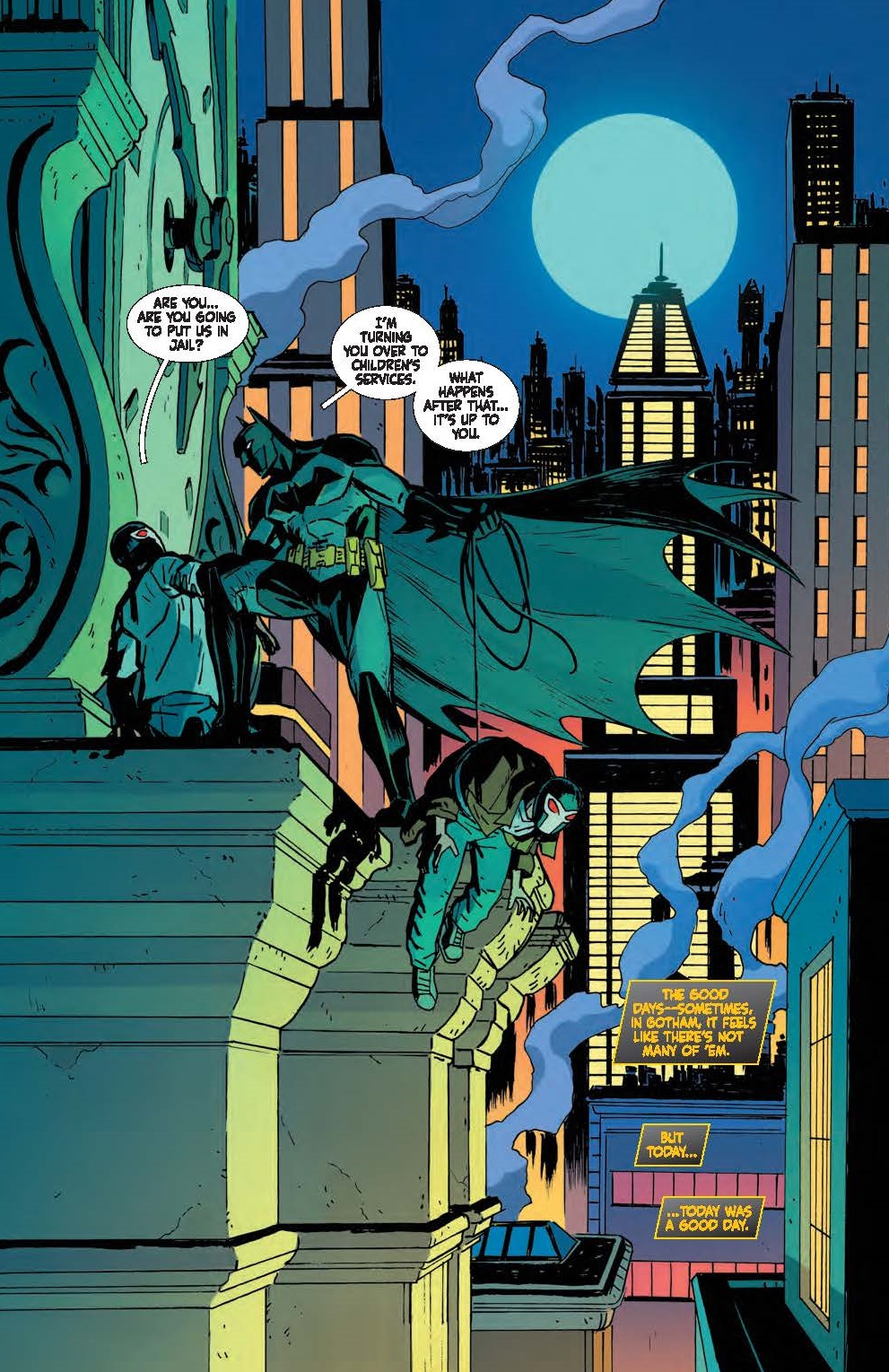Despite Bruce Wayne’s enduring 80-year run as the Batman, he isn’t the only character who has donned the cape and cowl. Jean-Paul Valley most famously took over as Batman in 1993’s “Knightfall,” while Dick Grayson succeeded his mentor during Grant Morrison’s time writing the character in the 2000s. Young Terry McGinnis was recruited by a retired Bruce in the Batman Beyond animated series. And Damian Wayne, Tim Drake, and Jim Gordon have also had turns as the Dark Knight.
This month’s Future State: The Next Batman miniseries introduces yet another heir to Bruce Wayne’s legacy: Tim Fox, the other son of longtime Batman ally Lucius Fox and the first Black character to wear the Batsuit, a major milestone for the superhero and DC Comics. Written by Oscar-winning screenwriter John Ridley (12 Years a Slave, The Other History of the DC Universe) and drawn by Nick Derington (Batman Universe), The Next Batman #1 makes Tim the protector of the Gotham City of the near future, a police state terrorized by militarized law enforcement and a Bane-worshiping gang of criminals.
Ever since Tim was revealed as the next Caped Crusader, some fans have wondered whether he is the right character for such a pivotal moment in the character’s history. After all, Tim has only appeared a handful of times since his introduction as Lucius’ rebellious son in the comics in 1979. Since then, he’s rarely been in the spotlight…or mentioned at all. In fact, despite being part of one of the most prominent families in the Batman mythos, it’s likely that many fans will be meeting Tim for the very first time here.

Why not Luke Fox or Duke Thomas, two much more high-profile Black characters who have worked with Batman for years and have each headlined their own solo books and stories? Both seem to be in better positions to succeed Bruce.
“Tim was the first choice,” Ridley tells a group of journalists during a roundtable in December, describing “a year of planning” that took the Next Batman from DC’s scrapped 5G relaunch to the more contained Future State event that bridges the gap between the multiverse-altering events of Dark Nights: Death Metal and a new era for DC called Infinite Frontier, which begins in March. “Whether it was 5G, whether it was Future State, there was a real commitment to have Batman be represented as a person of color.”
While Tim’s relative obscurity and skin color are likely to spark important conversations about the Caped Crusader, Ridley says that the goal of The Next Batman itself isn’t to do something radically different with the Dark Knight but to tell stories that feel fundamental to the character while fleshing out the reasons why Tim has returned to Gotham to become a crime-fighter and what that means for his family.
“I think the great thing about The Next Batman is it’s not being opposite Bruce Wayne, or different from Bruce Wayne, or denying Bruce Wayne, it’s embracing all those things that have made Bruce and Batman one of the most enduring characters in literature, and saying, ‘Okay, what’s next for that lineage?’ It’s not different Batman, it’s not anti-Batman, it’s next. And next is building on the past and really making it urgent and durable in the moment and for tomorrow.”
According to Ridley, one of the reasons Tim was chosen to headline The Next Batman was that much of his story was yet to be explored, providing an excellent blank slate for a new take on Batman.
“To a degree, Batman has had folks out there that he’s personally trained. Folks out there that wanted that. The mantle, the cowl. Folks who needed to step in on occasion. And the thing that’s always a differentiator is why? What is that narrative? What did they want? What drove them to it?
“There are a lot of folks out there, a lot of the characters out there that could have been Batman, but for me I think their motivations were not hyper clear. And I didn’t want to force change to either the detriment of stories that came before, or having to overly modify what was going to come. And Tim just allowed for a really particular narrative which we believe is going to allow for a very particular incarnation of his Batman.”

Despite taking place in a “possible near future” not necessarily tied to the primary DC continuity as it currently is, the first two issues of The Next Batman are reminiscent of classic Batman yarns. In the first issue, Tim must prevent two orphaned brothers from going down a dark path from which they can’t return, while the second story allows Tim to show off his detective skills, all while evading the militarized police force that is hunting him around the city. The stories do feel pretty “fundamental,” down to the colorful palette of blues and yellows used by colorist Tamra Bonvillain that nods to the Dark Knight’s earliest Golden Age appearances. Even the Batsuit of the future remains largely unchanged.
But when it comes to a new character taking on the role of Batman, one of the big questions creators have to ask themselves is what separates the new incumbent from Bruce Wayne? After all, you don’t just want to repeat the same exact story but with a different character.
“For me the biggest difference really is family. I mean, everything about Bruce was driven by the loss of his family. And on the page, never really being able to attach himself to people,” Ridley says. “Tim has his family. And that family is always there. And he, too, is driven by family, but in a very different way. And he’s going to have to reconcile much of that in real time.”
Indeed, Tim’s estrangement from his family heavily informs the book. His attempts to reconnect with them after his long absence from Gotham are met with hostility from Luke, who refers to Tim as the “the Fox family screw up.” And that disconnect extends to his mother Tanya too, who is a major proponent of the heavily-armored police working to keep the Gotham City streets “mask-free” after her daughter Tam lands in the hospital due to a mask-related incident (it’s unclear what exactly happened to her). It’s an interesting dynamic that not only sets Tim’s story apart from Bruce’s but also allows Ridley to flesh out each member of the Fox family beyond their connection to Lucius.
“They’ve been incredibly integrated into the Batman, the Bat universe, certainly with Lucius. The character goes from the page to the screen, they become indelible. And what he represents as a friend, as a partner, as a father figure for Bruce, as a character that the world sees, as a remarkable man who has the capacity to run one of the largest companies in America. That’s pretty remarkable in and of itself, but Luke has risen to a particular level on the page, and he hasn’t gone beyond that yet. Tanya, she never stated what her job was, what her role was. Same with the sisters, and certainly with Tim.”

While one of Ridley’s key goals with The Next Batman is to present a complex, fully fleshed-out Black family at the center of the Batman universe, he also tackles issues of policing in the book. Although Ridley began planning The Next Batman months before George Floyd’s death at the hands of Minneapolis police officers and the globe-spanning Black Lives Matter protests that followed, the book could be construed as a direct response to those events. The writer is keenly aware that some readers will feel the book is too “political.”
“Unfortunately for me, just as for pretty much every Black person in America, this moment that we’re going through right now, it’s hyper realized, it’s very raw, and while the wider culture, certainly the prevailing culture, is very aware of it, this isn’t new for us,” Ridley says. “I know going into it, having a young Black man who is going to be an extension of law enforcement, in this world you don’t have the hyper realizing of that. There are going to be people who just recognize, ‘Okay, the storytelling has the capacity to be very politicized.’”
But Ridley points out that many of the things he’s talking about in The Next Batman have long been a part of stories set in Gotham — they’re just not often explored from the perspectives of non-white characters.
“I know what Batman represents just in terms of individuals who want to just have a good read. But I know that Batman is always dealing with crime, dealing with impoverished areas, dealing with street level crime, dealing with systemic crime. It’s always been there. But yes, you make that character Black, you talk about a militarized police force, you talk about policing, and it becomes more political.”

The Next Batman has a lot of ground to cover for a four-issue miniseries, both in terms of fleshing out its characters and this new version of Gotham as well as the bigger themes. Are four issues really enough to re-introduce Tim to readers, tell a multi-character story about the Fox family, and tackle criminal justice in Gotham City? After reading the first two issues, which largely focus on world-building with some character work mixed in, I’m not sure such a short miniseries is really enough space.
Fortunately, The Next Batman is designed to be the start of a Bat saga for Tim, not the beginning, middle, and end. And that story will unfold across several books releasing this year.
“I can say that there has been a long term plan for what’s going to happen. And certainly, in the early phases of the storytelling it’s going to be very much within a hyper-specific Bat universe,” Ridley says, explaining that Tim’s story is designed to be both cohesive with the rest of the Batman books, including the flagship currently written by James Tynion IV, as well as a unique corner of the mythos. Tim’s already been mentioned in Tynion’s run, with an appearance teased for some point in the future.
After the four-part miniseries, Tim Fox will next be seen in Batman: Black and White #3 in a story penned by Ridley and drawn by Olivier Copiel. This short tale will introduce Tim’s own sidekick. “She’s not exactly Robin!” teases the solicitation. The issue is out on Feb. 23.
Where is this story ultimately headed? Will Tim eventually star in his own solo book or event series? Ridley isn’t saying just yet.
“There are other very specific plans that have been created that are going to be implemented [to] make Tim very much his own individual, his own character, and have his own emotional velocity to his storytelling.”
Whatever may be in store for Tim and his family, it’s not lost on Ridley that he now has the keys to one of the most important sandboxes in comics, and that the stories he tells could have long-lasting effects on the Caped Crusader’s world. While Ridley’s journey with the Batman is still in its opening act, he already has some thoughts on what legacy he hopes this story will leave behind.
“The legacy would be to leave a wholly rendered family, and that any of these characters can move on and inhabit other spaces in the DC universe. Whether they’re heroes, whether they’re just prominent characters that can be in legal professions, business, finance. If 15 years from now every one of the characters within the Fox family was a strong, durable, well-known, well understood individual character, that when they showed up they had history, and a history with specific narrative events, to me, that is the legacy that I would love to leave.”
Future State: The Next Batman #1 is out on Jan. 5.
